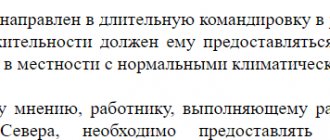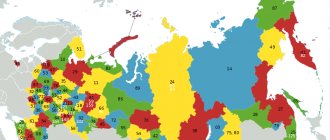What act introduced the list of localities equated to regions of the Far North
In 2022, the regions of the Far North (hereinafter referred to as the KS) were named in Resolution of the USSR Council of Ministers dated 01/03/1983 No. 12, which contains a list of regions of the Far North and localities equated to them (hereinafter referred to as the list).
It should be noted that due to the fact that this list was adopted at the end of the 20th century, corrections were repeatedly made to it. The last change took place on February 27, 2018 and was marked by the classification of the city of Kedrovy, Tomsk region, as an area equated to the regions of the Far North.
About the benefits to which workers in the Far North are entitled, read the article “What benefits are available to workers in the Far North?”
Starting from 2022, the list of regions of the Far North will be regulated by a single document, Presidential Decree No. 651 dated November 12, 2021, with the entry into force of which, from January 1, 2022, a number of decrees classifying regions as northern will no longer be in force. We talked about the innovations in more detail in this publication. At the same time, the new approved list is no different from the previous one, despite the cancellation of a number of regulatory acts, and geographically all regions that were previously equated to the Northern ones will remain so. A new Presidential Decree was adopted with the aim of structuring the list of such districts and their compliance with the modern municipal-territorial division.
List of regions of the Far North
According to the laws of the Russian Federation, in 2022 a list of regions of the Far North and districts comparable to them was approved. The basis of the Law of the Russian Federation is the decree of the Soviet Union of January 3, 1983. Here a decree was placed on a complete list of northern districts. This decree is called “Resolution 12”. Later, changes were made here, and starting from March 3, 2012, the already clarified (with amendments) twelfth resolution is in force.
Map of the regions of the Far North and territories equated to them
At the moment, the version of Resolution 12 dated 03/03/2012 is valid. According to it, Beloyarsky district and Berezovsky are now regions of the Far North of Russia. Islands located in the Arctic Ocean and corresponding to the Okhotsk and Bering Seas are also included. The list below contains all areas related to the Far North. So, the list includes: Tyumen, Murmansk, Arkhangelsk regions, Krasnoyarsk Territory and Komi Autonomous Soviet Socialist Republic.
- Tyumen includes: Yamalo-Nenets region;
- to Murmansk: the entire territory of this region;
- to Arkhangelsk: Nenets, Leshukonsky, Pinezhsky, Mezensky districts and the entire territory of Severodvinsk;
- to the district of the Krasnoyarsk Territory: completely Taimyr and Evenkiysk, the city of Igarka and the city of Norilsk, the northern part of the Yenisei region and the entire Turukhansky district;
- to the Komi Republic: the cities of Pechora, Vorkuta, Inta and the village of Ust-Lyzha, as well as the areas under their subordination.
On the basis of the Federal Law of our country, three regions were united: Taimyr, Evenki and Krasnoyarsk. Now they all together make up the Krasnoyarsk Territory. Another change is that the Kamchatka region merged with the Koryak region. This led to the establishment of a new facility. Namely, the Kamchatka Territory. Therefore, the following list includes changes. A similar thing happened with Chukotka. Now it is a separate region of Russia. Which regions are classified as the Far North as a result of the changes? In addition to the areas listed above, these are:
- Katagansky district of the Irkutsk region;
- Republic of Sakha (formerly Autonomous Soviet Socialist Republic of Yakutia);
- Magadan Region;
- Kamchatka Krai;
- Karelia and its regions: Kemsky, Loukhsky, Belomorsky and Kalevalsky, as well as the city of Kostomuksha;
- Khanty-Mansiysk with Berezovsky and Beloyarsky districts;
- Khabarovsk with the Okhotsk and Ayano-Maisky districts;
- Sakhalin includes the Kuril, North and South Kuril regions, as well as Noglisk, Okhinsk and their districts, the city of Okha;
- to Tyva: Kyzylsky, Mongun-Taiginsky and Todzhinsky districts.
Which regions from the list belong to the Far North?
Some regions of the country will fully belong to the CS areas from 2022:
- Kamchatka Krai;
- Magadan Region;
- Murmansk region;
- Yamalo-Nenets Autonomous Okrug;
- Nenets Autonomous Okrug;
- Chukotka Autonomous Okrug;
- Yakutia;
- islands:
- Arctic Ocean;
- Bering Sea;
- Sea of Okhotsk.
Other territories of the CS consist of individual districts, cities or other municipalities of various regions of the Russian Federation.
The list of regions of the Far North can be downloaded here:
What payments do not need to apply the regional coefficient?
The regional coefficient does not apply to material assistance, employee incentives not related to the performance of labor functions and production results, to payments under employment contracts calculated based on average earnings:
- vacation pay;
- vacation compensation upon dismissal;
- payment of average earnings for the period of a business trip;
- payment for downtime;
- average earnings for donor days;
- other.
These payments already include regional coefficients, since the calculations use the amounts of wages and other labor income that have already been calculated taking into account increasing coefficients.
Study the features of regulating work and rest schedules for employees, types of work schedules, features of summarized recording of working time and its application for remuneration of employees at the seminar: “Features of summarized recording of working time: legal aspects of regulation and recording of working time, drawing up shift schedules.”
Find out how to pass a GIT inspection with minimal sanctions at the seminar: “Changes in labor protection 2021-2022.”
What are the features of regions and localities equated to regions of the Far North?
The regions of the CS are characterized by more severe climatic conditions compared to other regions of Russia. In order to compensate for harm suffered in connection with living and working in the territories of the Constitutional Court, the authorities of the country and the subjects themselves provide various kinds of preferences for the population. These preferences are expressed:
- in bonuses and the application of regional coefficients to wages;
In the Guide to Personnel Issues you will find a list of regions of the Far North and equivalent areas in which percentage bonuses are paid for length of service. If you have access to ConsultantPlus, check whether you are applying regional allowances correctly. If you don't have access, get a free trial of online legal access.
- provision of additional leaves;
- other benefits provided for by the laws “On State Guarantees and Compensations...” dated February 19, 1993 No. 4520-1, “On Housing Subsidies” dated October 25, 2002 No. 125-FZ (hereinafter referred to as Law No. 125-FZ), “On Insurance Pensions” dated December 28, 2013 No. 400-FZ (hereinafter referred to as Law No. 400-FZ) and Ch. 50 Labor Code of the Russian Federation.
Let's look at the main features of these benefits:
- Preservation of the employee’s average earnings for 4–6 months from the date of his reduction or upon liquidation of the company (Article 318 of the Labor Code of the Russian Federation).
Read about guarantees for CS employees upon dismissal in the material “Art. 318 Labor Code of the Russian Federation: questions and answers" .
- The length of the working week for women is 36 hours (Article 320 of the Labor Code of the Russian Federation).
- Payment for travel to the vacation spot and back (Article 325 of the Labor Code of the Russian Federation).
The Ministry of Finance spoke about insurance premiums and personal income tax on income in the form of regional coefficients to the salaries of workers working in the Far North and equivalent areas. Get free trial access to the K+ system and find out the opinion of officials.
- An additional day off at your own expense for a parent with children under 16 years of age (Article 319 of the Labor Code of the Russian Federation).
- Additional leave (Article 321 of the Labor Code of the Russian Federation):
- for KS districts - 24 calendar days;
- for areas equated to them - 14 days.
For more details, see “Vacation in the Far North - what is the duration?”
- The level of regional coefficients is set by the subjects, for example:
- for the Kamchatka Territory - 1.8 and 2 for the Aleutian municipal region (Article 4 of the Law “On Guarantees and Compensations...” dated March 6, 2008 No. 15);
- for the Tomsk region - 1.5 and 1.3 depending on the region (Resolution of the Government of the Russian Federation “On increasing regional coefficients ...” dated May 13, 1992 No. 309).
- 100% of the salary if the period of residence at the KS is 5 years or more;
- for civil servants - 30%;
- for persons under 30 years old - 30% if they have lived in the region for 5 years.
- for the Murmansk region for persons under 30 years of age (Article 6 of the Law “On State Guarantees and Compensations” dated December 23, 2004 No. 579-01-ZMO):
- for the Krasnoyarsk Territory (Article 3 of the Law “On Guarantees and Compensations...” dated December 3, 2004 No. 12-2668):
Read more about the size of the northern allowance here.
- Social assistance for the purchase or construction of housing for persons moving from the districts of the Constitutional Court (Law No. 125-FZ). The size of the payment depends on the length of service: the minimum percentage of payment calculation is 75% for disabled people of the 1st or 2nd group or for persons with work experience of 10–15 years and 100% for citizens with work experience of more than 35 years.
- Retirement age: women - from 45 or 50 years old, depending on the length of service, men - from 50 or 55 (Article 32 of Law No. 400-FZ).
For information on how northern seniority is calculated, read the article “Calculation of northern seniority for men upon retirement .
Regions and cities equated to regions of the Far North
The Far North includes and is equivalent to:
- Localities of the Perm Territory (the Komi-Permyak Autonomous Region was included in the warehouse of the Perm Territory): Kosinsky, Kochevsky, Gainsky.
- Territories of Arkhangelsk: Shenkursky, Ustyansky, Krasnoborsky, Vinogradovsky, Konoshsky, Nyandomsky, Kotlassky, Velsky, Lensky, Kargopolsky, Vilegodsky, Verkhnetoyemsky districts and cities: Kotlas, Koryazhma, Novodvinsk, Arkhangelsk, Onega.
- The Tyumen region includes: Khanty-Mansiysk (not counting the Berezovsky and Beloyarsky territories) and Uvatsk.
- Ugra has now separated from Khanty-Mansiysk, and is a separate Region of our country.
- Districts of Karelia: Loukhsky, Olonetsky, Kalevalsky, Kondopoga, Medvezhyegorsky, Belomorsky, Pudozhsky, Segezhsky, Prionezhsky, Muezersky, Kemsky, Pryazhinsky, Lakhdenpokhsky, Suoyarvsky, Pitkyaranta. This also includes the cities of Sortvala and Petrozavodsk.
- Autonomous Republic of Komi: Udora, Ust-Vymsky and Ust-Kolomsky, Sosnogorsky, Syktyvdinsky and Vuktylsky, Knyazhpogostsky, Sysolsky, Kortkerossky, Troitsko-Pechora, Priluzsky and Koygorodsky districts. And the city of Syktyvkar, as well as Ukhta and its entire territory.
- Irkutsk: Ust-Kutsky and Ust-Ilimsky districts with their cities. Bratsky district and its city, Bodaibo district together with the city, Kazachinsko-Lensky, Nizhneilimsky, Kirensky, Mamsko-Chuysky areas.
- Tomsk region: Kolpashevsky and Bakcharsky, Parabelsky and Aleksandrovsky, Verkhneketsky and Chainsky, Krivosheinsky and Teguldetsky, Molchanovsky and Kargasoksky districts. Also the city of Strezhnevoy and the city of Kolpashevo.
- Tungiro-Olekminsky, Kalarsky and Tungo-Kochensky districts of the Chita region.
- The rest of Sakhalin. That is, not counting the territory that is on the list of regions of the Far North. This area is almost entirely included in the list of areas equated to them.
- Krasnoyarsk Territory: Lesosibirsk and the entire adjacent territory and Yeniseisk with its area. Also the districts: Kezhemsky and Boguchansky, and Motyginsky.
- Autonomous region of Tyva. This includes: Kyzyl region except Shinaan area. Also Bai-Taiginsky, Chaa, Chedi and Sut-Kholsky, Kaa-Khemsky, Pius and Ulug, as well as Tes-Khemsky districts. Barun-Khemchiksky and Dzun-Khemchiksky, Ovursky and Erzinsky, and Tandinsky are also among them. And of the cities equated to the Northern regions - Kyzyl.
- The Autonomous Republic of Buryatia includes Muisky, Bauntovsky, Barguzinsky, Okinsky, Severo-Baikalsky and Kurumkansky districts.
- Khabarovsk and its surrounding areas: Omminsky, Vaninsky, Tuguro-Chumikansky, Voznesensky, Verkhnebureinsky, Sovetsko-Gavansky, Padalinsky, Komsomolsky, Solnechny, Achansky, Dzhuensky, Nikolaevsky and Ulchsky districts. The cities are also included: Sovetskaya Gavan, Komsomolsk-on-Amur, Nikolaevsk-on-Amur and Amursk itself. This also includes the labor town of Elban, in the Amur region, with the entire adjacent territory.
- Region of Amursk and its surroundings: the city of Tynda with all the terrain belonging to its city council and the city of Zeya. Also: Tynda, Zeya and Selemdzhinsky districts.
- Autonomous Republic of Gorny Altai and its districts: Ulagansky and Kosh-Agachsky districts.
- Primorsky territory: Olginsky, Dalnegorsky, Tarneysky and Kavalerovsky districts. The settlement for workers is Vostok, which is located in the Krasnoarmeysky district and the entire area is under the leadership of the settlement council of the same city. And the districts: Krasnoarmeysky, Melnichny, Boguslavetsky, Roshchinsky. Includes Vostretsovsky, Taezhnensky, Dalnekutsky and Izmailikhinsky districts.
Results
Many regions of Russia, due to difficult climatic conditions, are considered regions of the Far North or areas equivalent to them. This list is constantly updated. Residence and employment of people in such regions provide a greater range of guarantees related to wages, leave and others provided for by local regulations.
Sources:
- Information from the website of the Government of the Russian Federation
- Decree of the Government of the Russian Federation of November 16, 2021 No. 1946
You can find more complete information on the topic in ConsultantPlus. Free trial access to the system for 2 days.
Which employees are eligible for district coefficients in 2022
Regional coefficients apply to main employees, part-time workers and employees working on a rotational basis (Articles 316, 285 of the Labor Code).
Additional supplements should be added for the following types of payments:
- remuneration for actual time worked (official salary or wage rate);
- bonuses for production, regardless of the frequency of payments;
- additional payments for special working conditions (harmful, dangerous, difficult, etc.);
- additional payments for working on holidays and weekends;
- additional payments for night work;
- additional payments for overtime and overtime;
- the cost of valuable gifts given in the form of incentives or bonuses.
If the payment is not directly related to the work performed, then the regional coefficient does not need to be applied (for example, expenses associated with paying for a business trip).








